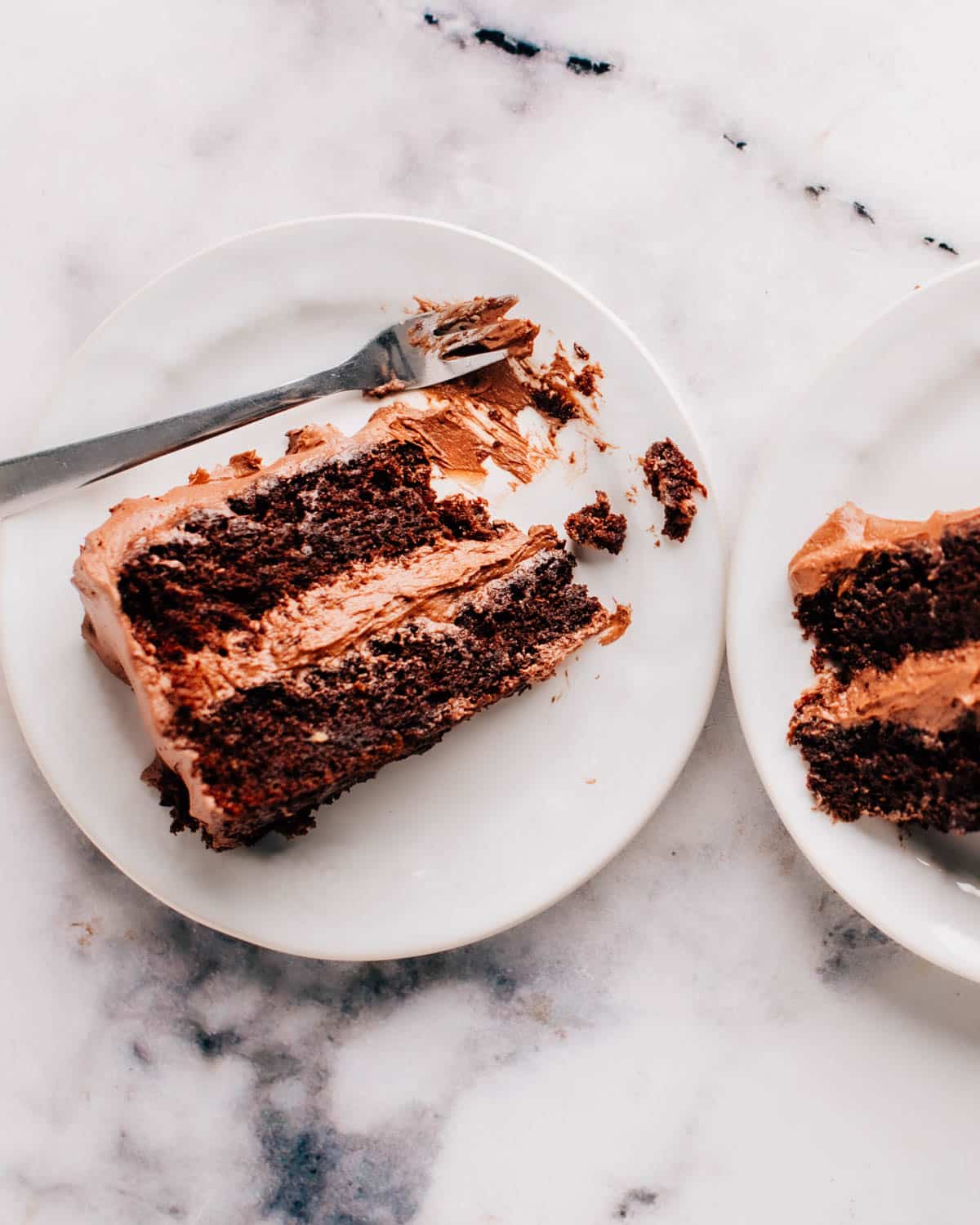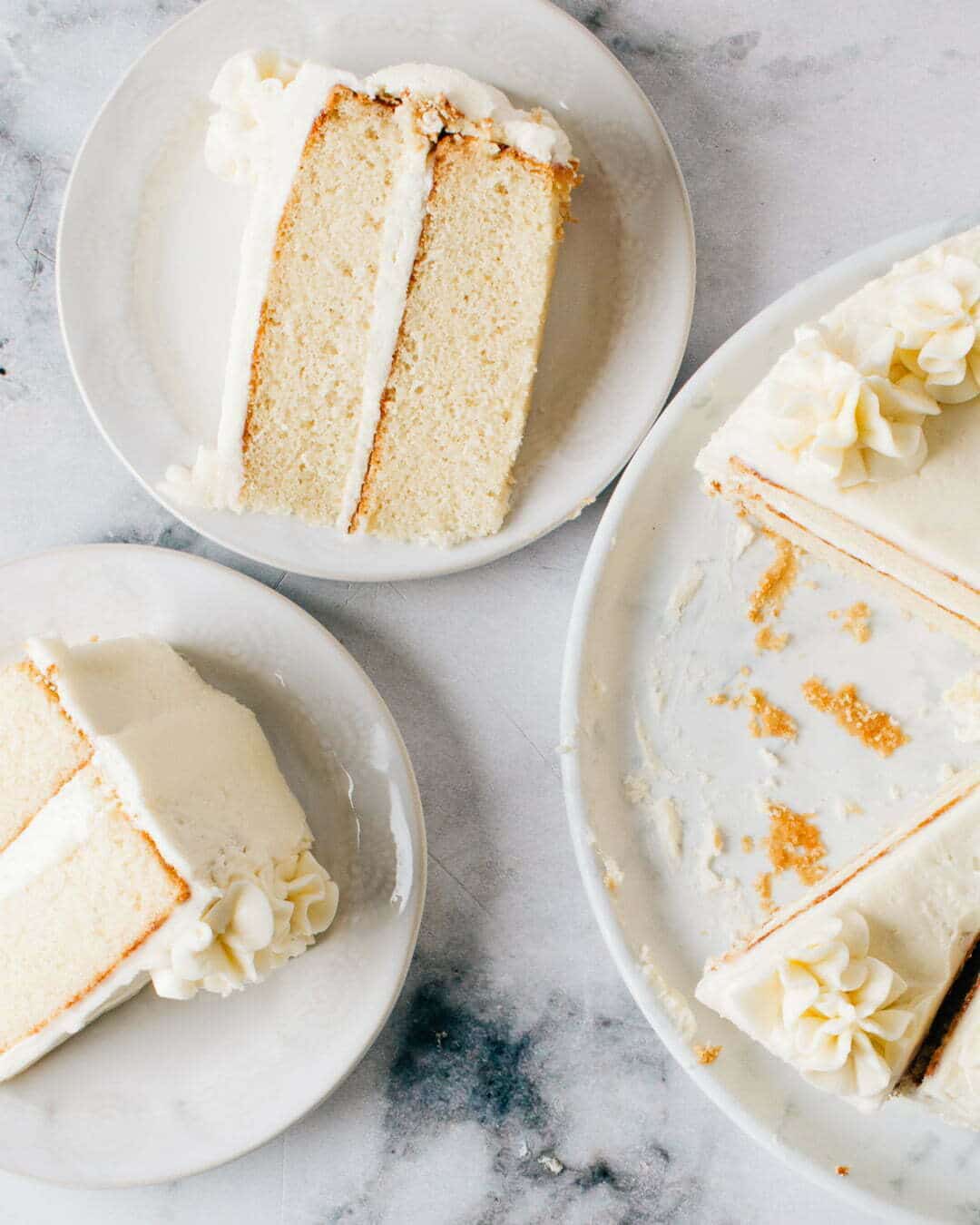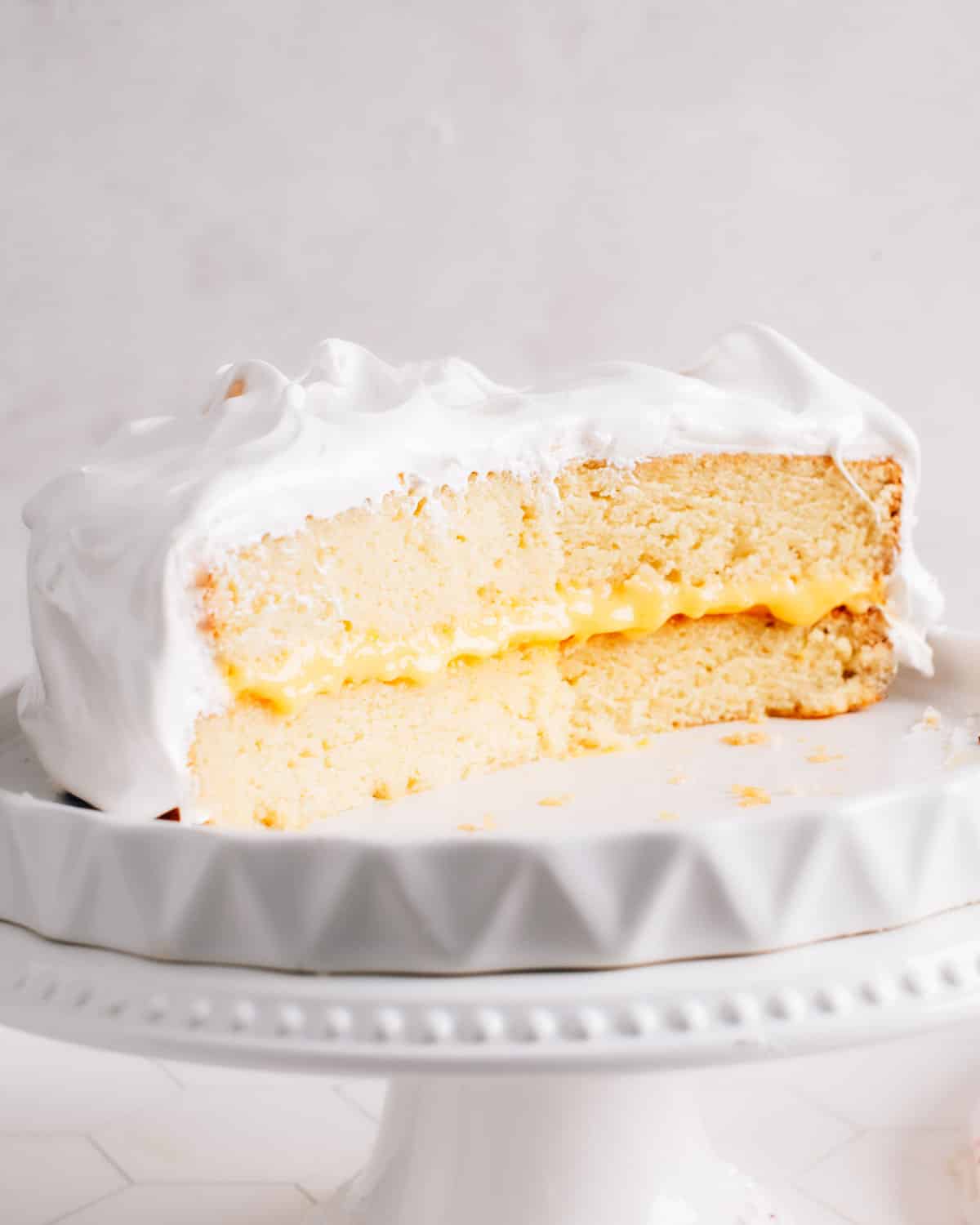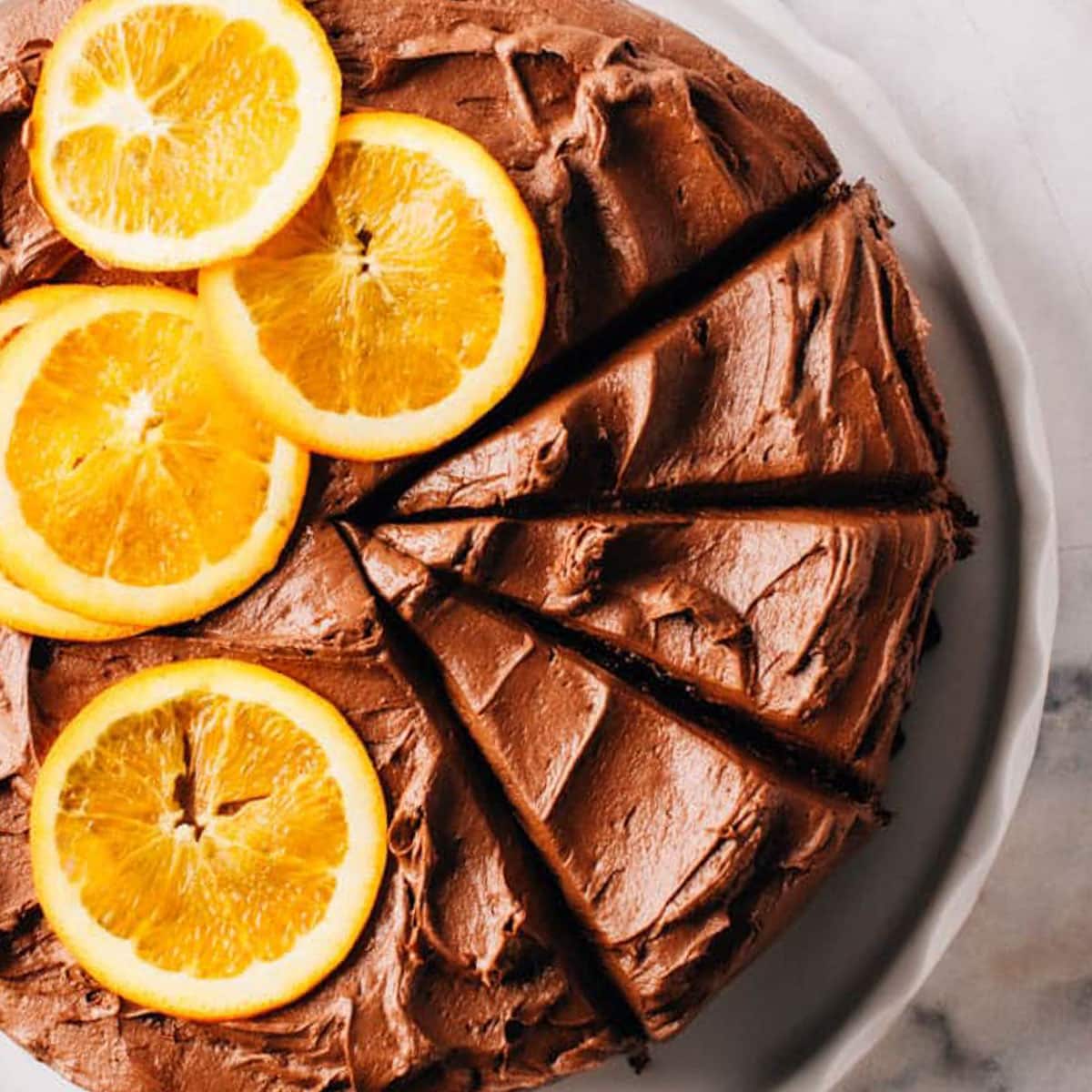How Long Does Cake Last in the Fridge? Here’s Everything You Need to Know About Refrigerating Cake.
Sep 18, 2023, Updated Nov 20, 2023
A food scientist’s guide to answer the question “how long does cake last in the fridge” as well as a simple storage guide and pro tips.
Got leftover cake and thinking of stashing it in the fridge? Hold on a sec. While the fridge can give your cake a bit more time, it’s not a magic fix. I’m a Food Scientist and I’m going to break down the pros, cons, and signs to watch for when it’s time to say goodbye to that last slice.
How Long Does Cake Last in the Fridge?
Let me lead with a quick answer so you don’t have to scroll to find what you came here for. Here’s a simplified guide for how long different types of cakes might last in the fridge:
- Plain Cake (like unfrosted Moist Vanilla Cake): About 5-7 days in the fridge.
- Cake with Buttercream, Whipped Cream or Custard (like Moist Chocolate Cake with Fluffy Chocolate Frosting): 4 days, since dairy spoils quicker.
- Fruit-filled Cake (like Lemon Curd Cake) 3-5 days, depending on the acidity and moisture content of the fruit filling or topping.
Read on to get the details on how to store it so it lasts longer, doesn’t smush your icing, and my favorite alternative to refrigerating cake.
The Basics of Cake Storage
When it comes to keeping your cake fresh, there are a few key factors you need to consider: ingredients, moisture content, and how you store it.
- Ingredients: A cake with dairy-based fillings or frostings will spoil faster than a plain sponge cake.
- Moisture Content: Dry cakes tend to last longer since moisture can encourage mold growth. On the flip side, dry cakes are… dry. I’ll take a moist cake any day (like my almost-famous Moist Chocolate Cake and Moist Vanilla Cake)
- Storage Method: An airtight container can work wonders in keeping cake fresh, whether you store it in the fridge or not.
Different cakes have different lifespans. A fondant-covered wedding cake will last longer than a carrot cake with cream cheese frosting simply because it’s less prone to moisture loss and spoilage.
Benefits of Refrigerating Cake
Tossing that cake in the fridge comes with a couple of perks:
- Extends Shelf Life: The cool temperature slows down the spoilage process, giving you a few extra days to enjoy the cake.
- Preserves Fillings: If your cake has cream, custard, or fruit fillings, refrigeration can keep those fresh for a longer period.
But how long does cake last in the fridge for real? Longer than at room temperature from a spoilage perspective, but not from a quality perspective.
Limitations of Refrigerating Cake
However, the fridge isn’t a cure-all. Here are some caveats:
- Texture Changes: Storing cake in the fridge can actually SPEED UP the staling process due to the cooler temperatures causing changes in the starch. The technical term is starch retrogradation, and the result is a drier, stiffer texture (what we call “stale”).
- Flavor Transfer: Got some strong-smelling foods in the fridge? Those odors can seep into your cake.
- Not a Forever Fix: Refrigeration can delay spoilage but won’t stop it. You’ll still need to eat that cake within a reasonable time frame.
How long can cake sit out unrefrigerated?
The time a cake can safely stay at room temperature varies depending on its ingredients and how it’s stored. But here’s a general guide:
- Plain Cake: If it’s a simple sponge or pound cake with no dairy-based fillings or frostings, you can usually keep it at room temperature for up to a week if it’s well-wrapped or stored in an airtight container.
- Cream or Custard Filled: These should be refrigerated as soon as possible, but if you must, they can stay out for a few hours, depending on the room temperature.
- Buttercream or Fondant Covered: These types of cakes can generally stand up to room temperature a bit better than others. A cake with buttercream or fondant could last up to 3 days at room temperature, depending on the filling.
- Fruit-Filled or Topped: If the cake has fresh fruit, fruit filling, or a fruit-based frosting, aim to eat it within 24 hours if kept at room temperature. The extra moisture makes it more prone to spoilage.
Always store your cake in a cool, dark place away from direct sunlight, and use an airtight container or well-sealed plastic wrap to protect it from air and potential contaminants. Also, keep in mind that high humidity can affect the cake’s quality.
Regardless of these guidelines, always check for signs of spoilage like mold, off-putting smells, or changes in texture before diving in.
Signs of a Spoiled Cake
Knowing when it’s time to part ways with that leftover cake is crucial for both taste and safety. Keep an eye—or nose—out for these warning signs:
- Visual Cues: Mold is the most obvious sign. But also look out for discoloration, especially in the cream or fruit fillings.
- Olfactory Cues: A cake that’s going bad will often have an off-putting or sour smell. If your cake smells like anything other than cake, it’s time to toss it.
- Textural Cues: If the cake feels overly hard or you encounter mushy spots, that’s a sign that it’s either dried out or beginning to spoil.
A Quick Step-By-Step Guide to Refrigerating Cake
Here’s a quick and easy guide for refrigerating cake:
- Cool Down: Let your cake completely cool to room temperature if it’s freshly baked. This prevents condensation from forming inside your storage container.
- Slice or Keep Whole: Decide if you’re storing the entire cake or individual slices. Slices often take up less space but can dry out faster.
- Wrap It Up: Use plastic wrap to cover the cake or slices tightly. The aim is to keep air out to reduce the risk of drying and spoilage.
- Use an Airtight Container: For an extra layer of protection, place the wrapped cake or slices in an airtight container.
- Label It: Stick a piece of masking tape with the date on the container so you’ll remember how long it’s been in there.
- Fridge Placement: Put the cake in the least crowded part of your fridge, ideally where it won’t absorb any strong odors. A middle shelf usually works well.
- Consume Quickly: Aim to eat the cake within the timeline suited to its type to enjoy it while it’s still good.
- Check for Spoilage: Before eating, check for any signs of spoilage like mold, off smells, or weird textures.
How to Store Cake in the Fridge without Ruining the Frosting
h, the frosting dilemma. You’ve spent time making that cake look nice, so the last thing you want is for the frosting to get smushed or peel off. Here are some tips to store your cake without ruining the frosting:
- Parchment Paper: Place a piece of parchment paper between the cake and the plastic wrap to protect the frosting. You can also place pieces of parchment paper against the sides if it’s a layer cake.
- Loose Tent: Create a ‘tent’ of plastic wrap or aluminum foil over the cake. Make sure it’s loose so that it doesn’t touch the frosting, but tight enough at the edges to seal in freshness.
- Cake Carrier: If you have a cake carrier or cake dome, use that. These are designed to keep cakes fresh without messing up their appearance.
- Inverted Bowl Method: Place the cake on a plate and cover it with a large, inverted bowl. This keeps the air out without touching the frosting. If your bowl isn’t airtight, you might want to wrap the whole assembly loosely in plastic wrap.
- Use Toothpicks: Stick some toothpicks into the top of the cake and drape the plastic wrap over them, creating a little tent that won’t touch the frosting.
- Store Upright: Always keep the cake flat and upright to avoid shifting and smearing of frosting.
So, it’s a bit of a balancing act, but these methods should help you keep that cake looking pretty while it’s being stored.
Alternatives to Refrigeration
Unless you’re going to eat the cake within a couple of days, I’m personally not keen on sticking that cake in the fridge. I really don’t like that it stales the cake faster. The good news is that you’ve got options:
- Freezing: For longer storage, consider freezing your cake. Just make sure to wrap it well to prevent freezer burn.
- Repurposing Leftovers: Turn that cake into something new, like cake pops, trifle, or even a cake shake. It’s a fun way to give those leftovers new life.
To Wrap Up
So we’ve dug into how to keep cake fresh and answered “how long does cake last in the fridge?” from a science-backed perspective.
I’ve offered up some pro tips for storage and timelines, but always check for signs of spoilage like mold, off-putting smells, or changes in texture before diving in.
Up Next:
- How to Make a Cake From Scratch: The Ultimate EASY Guide
- Parchment Paper 101: Everything You Need to Know
Burning questions? Feel free to drop them in the comment section!
Fan-Favorite Cakes Recipes to Try
I can’t leave you without sharing some favorite, tested-till-perfect cake recipes! Here are a few of my top cakes, from the mouths of readers like you:
- Moist Chocolate Cake: A shining star on the Foodess blog since 2009 with hundreds of positive reviews, you must try this one!
- Moist Vanilla Cake: Years of testing finally produced the soft, fluffy, moist vanilla cake of my dreams.
- Portuguese Orange Cake: A reader favorite on the website. It’s moist and packed with orange flavor.
- Chocolate Orange Cake: I love this fluffy whipped chocolate orange frosting slathered over a rich chocolate cake.
- Blueberry Pound Cake: A soft, fluffy and yes, MOIST blueberry pound cake that is so yummy you’ll be making it on repeat.
- Moist Carrot Cake: Yes, I do love the word moist. But this carrot cake recipe with fluffy cream cheese frosting is just the moistest!














Jennifer, thank you so much for these storage tips for layered cakes! As someone who loves them, I really appreciate your advice and expertise on this.
I had never heard of the inverted bowl method for storing cake before, but it’s such a great idea!
I love how your blog post includes tips for storing different types of cakes, from plain cake to fruit-filled cake!!
I recently made a cake with buttercream frosting and was worried about how to store it without ruining the frosting. These tips on using parchment paper and creating a loose tent were so helpful and ensured that my cake stayed looking beautiful. You’re the best Jenn!
As someone who loves to bake, I always struggle with how to store my leftover cake. So this guide is a game-changer – now I know exactly how long I can keep my cake fresh and delicious!